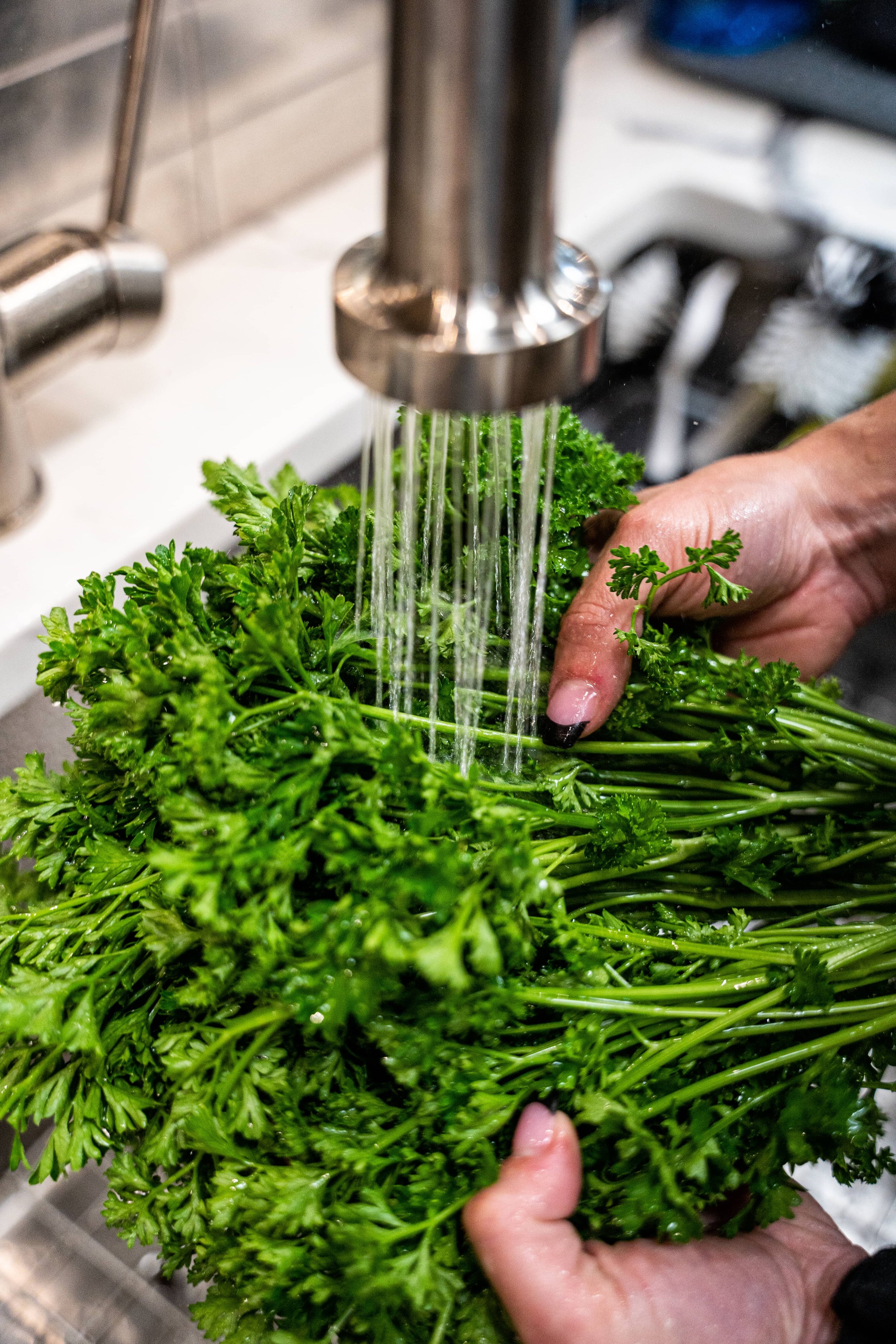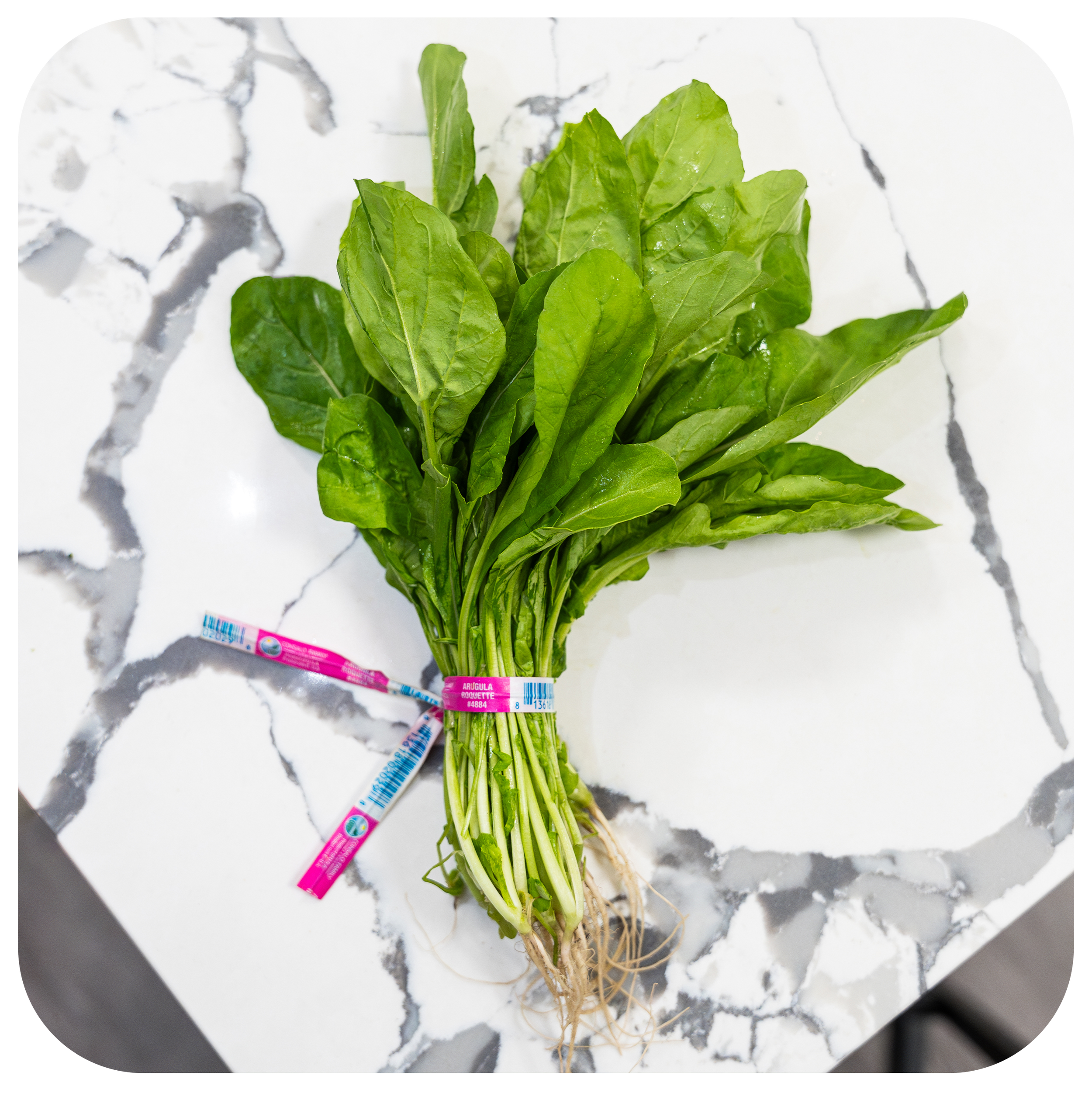
Herbs
-

Arugula
Arugula consists of vibrant green leaves attached to a pale, creamy, green-hued stem. The leaves can be harvested when fully mature, or when they are younger and have a milder flavor. Arugula offers a herbaceous, peppery flavor.
Arugula is a nutrient rich leafy green providing vitamin A, vitamin C, vitamin K, calcium, magnesium, riboflavin, copper, iron, zinc, folate and potassium. Arugula is also high in antioxidant phytochemicals. Many minerals in arugula help to control blood pressure and support eye health.
Our Favorite Ways to use Arugula — Summer Corn and Arugula Salad & Onion and Arugula Frittata
-

Cilantro
Cilantro resembles plain parsley but is distinguished by a distinct aroma and flavor. Cilantro is actually the leaves and stems of the coriander plant. It is an annual herb and a member of the carrot family. Cilantro is commonly known to be used in Mexican cooking but is also widely used in Asian, Thai, and Chinese cuisines.
Cilantro is one of the richest herbal sources of vitamin K. Recent studies show that cilantro has a detoxifying ability and can rid the body of heavy metal toxins. Cilantro can also protect the body from oxidative stress, fatigue, and anxiety.
Our Favorite Ways to use Cilantro — Cilantro Lime Shrimp and Beef & Cilantro and Lime Rice Bowls
-

Dill
Dill requires warmer temperatures to grow well. It grows 1 to 2 feet in height, very quickly, and has fern like leaves. It is a perennial herb and the flavor profile is a cross of lemon and parsley.
There are essential oils in dill that have therapeutic uses as well as anti-septic and local anesthetic uses. Dill has no cholesterol and many antioxidants. Dill is also known to prevent bacterial overgrowth.
Our Favorite Ways to use Dill — Homemade Tzatziki Dip & Dill Potato Salad.
-

Mint
Mint is a perennial herb. It has branched stems with leaves that are arranged in opposite pairs. The leaves are dark green, gray-green, and sometimes pale yellow. Mint is relatively tolerable of different climates, and thrives year-round.
Like other herbs, mint leaves offer a healthy way to flavor your meals, without using sodium-based seasonings. Mint offers a good amount of fiber, which reduces cholesterol and lowers the risk of obesity and weight gain. Mint leaves provide a considerable amount of vitamin A, which promotes healthy skin and supports your immune system.
Our Favorite Ways to use Mint — Homemade Mint Chocolate Chip Ice Cream, Classic Mint Julep Cocktail & Watermelon, Mint and Feta Salad
-

Dandelion
Dandelion leaves sprout from a hollow stem that is either green or red. Leaves have a variety of flavors, from mild to very bitter, depending on the size. Dandelion greens belong to the sunflower plant family.
Dandelion is high in calcium and rich in iron. It is a good source of protein, and is a detoxifier, like kale. Diuretic properties of dandelion greens make them useful for promoting urine production and reducing symptoms of some liver, gallbladder and kidney conditions.
Dandelion greens can be eaten raw and are often times enjoyed in salads. They are also sautéed, braised, and cooked with eggs. The flavor mellows when cooked. Dandelion can also be used in pesto recipes.
Our Favorite Ways to use Dandelions — Spring Fennel and Dandelion Slaw & Fresh Dandelion Salad with Hard Boiled Egg, Bacon and Shallot Vinaigrette
-

Plain Parsley
Plain Parsley, also know as Italian Parsley, has flat, green, loosely toothed leaves that are triangular. Plain parsley has peppery, tangy, and floral flavor notes. It has a much more robust flavor than curly parsley. Plain parsley is cultivated as an herb, vegetable, and spice. It is often used fresh, but can also be cooked.
Plain parsley has the same nutritional benefits as curly parsley. It is a good source of folic acid and contains vitamins and minerals. Keeping your parsley wrapped in a damp paper or kitchen towel in the refrigerator will keep it fresh for a few days. You can also treat the parsley much like a bunch of flowers. Trim the stems slightly, and without washing place the bundle in a container filled with about 1 inch of water.
Our Favorite Ways to use Plain Parsley — Plain Parsley Chimichurri, Roasted Parsley Potatoes & Mediterranean Parsley Salad
-

Curly Parsley
Curly parsley is a frost tolerant biennial plant. It has dark green leaves that have been classically seen as a garnish. The flavor profile of curly parsley depends on each plant. It can be very bland to very bitter. It is tougher and heartier than plain parsley.
Curly parsley can cleanse your palate and is a good source of folic acid, playing a critical role in cardiovascular health. It also contains potassium, manganese, iron, and magnesium. Keeping your parsley wrapped in a damp paper or kitchen towel in the refrigerator will keep it fresh for a few days. You can also treat the parsley much like a bunch of flowers. Trim the stems slightly, and without washing place the bundle in a container filled with about 1 inch of water.
Our Favorite Ways to use Curly Parsley — Tabbouleh Salad & Summer Parsley Salad with Cucumbers, Olives and Feta Cheese
